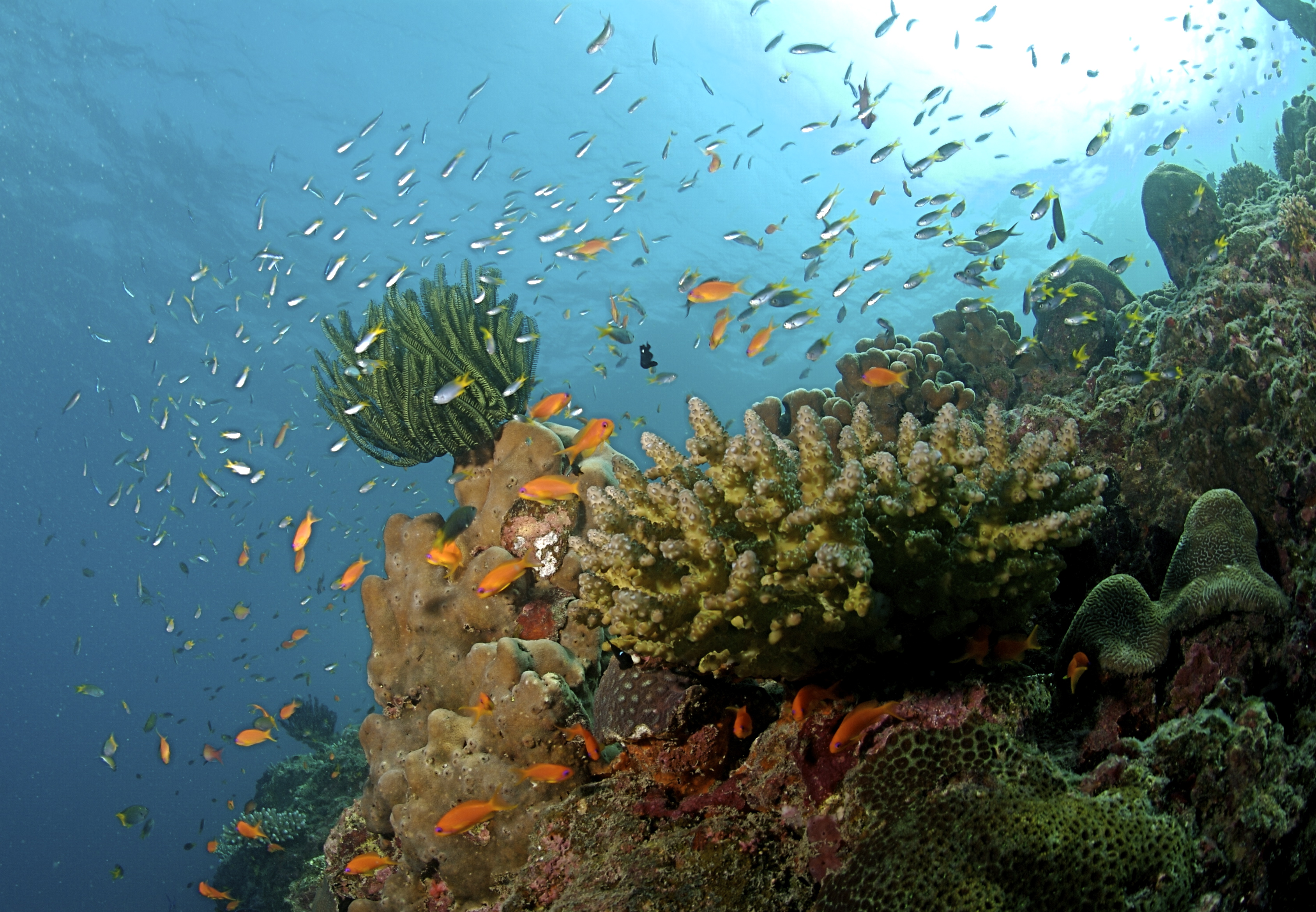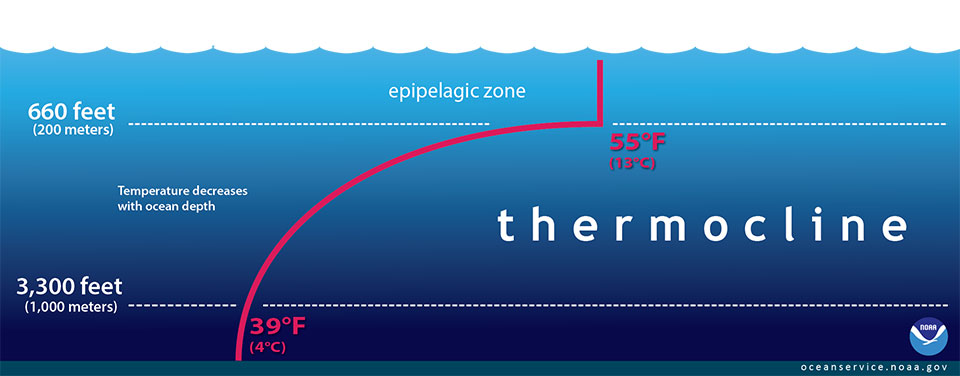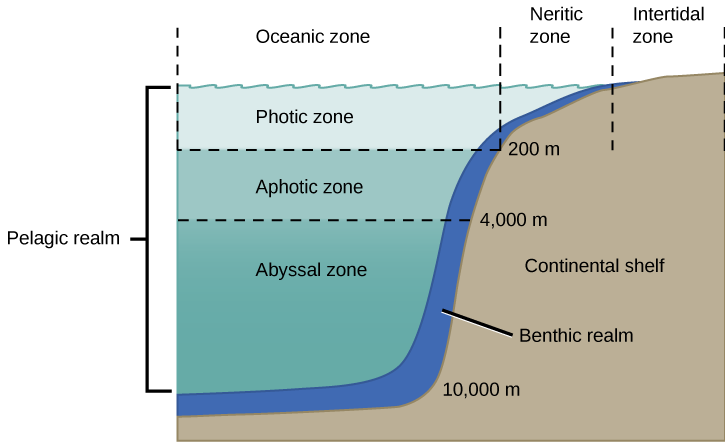8.1 Significance of Oceans
The oceans makeup 70% of the planet and contain 97% of all the water on Earth. Watch the video below that shows what the Earth would look like if all the ocean water were gone.
It also makes up most of the water stores the majority of the planet’s moisture, terrestrial energy, and heat from the Sun. This energy is transferred between the equator and the two poles by larger surface currents by winds and deep ocean currents driven by ocean density differences. It also supplies the moisture and energy for storm systems and, ultimately, global climates. (1) It is important to study the oceans, and their exploration is an exciting and ongoing process.
Phytoplankton, microscopic plants, and animals in the oceans provide the foundation of the global food web of species. They contain chlorophyll and require sunlight in order to grow, and provide food for a wide range of sea creatures. The earth’s oceans are so vital for life that over 40 percent of the world’s population lives near coastal areas. (1)
Moderate Climates
As terrestrial creatures, humans think of the importance of the planet’s land surfaces, yet Earth is a planet consisting of 70 percent water. From space, the dominance of water is clear because most of it is stored in Earth’s oceans. Earth would not be the same planet without its oceans. The oceans, along with the atmosphere, keep Earth’s surface temperatures relatively constant worldwide. Some places on Earth reach as cold as -7 degrees Celsius, while other places reach as hot as 55 degrees Celsius. On other planets like Mercury, temperatures range from -180 degrees Celsius to 430 degrees Celsius. (2)
The oceans, along with the atmosphere, distribute heat around the planet. The oceans absorb heat near the equator and then transport that solar energy to polar regions. The oceans also moderate the climate within a region. At the same latitude, the temperature range is smaller and coastal areas compared to areas farther inland. Along coastal areas, summer temperatures are not as hot, and winter temperatures are not as cold, because water takes a long time to heat up or cool down. (1)
Biologically Rich
The oceans are an essential part of Earth’s water cycle. Since they cover so much of the planet, most evaporation comes from the ocean, and most precipitation falls on the oceans.

The oceans are also home to an enormous amount of life. That is, they have tremendous biodiversity. Tiny ocean plants create the base of a food web that supports all sorts of life forms. Marine life makes up most of all biomass on Earth. Biomass is the total mass of living organisms in a given area. These organisms supply us with food and even the oxygen created by marine plants. (1)
Continental Margins
Recall from the chapter on Plate Tectonics that the ocean floor is not flat. Mid-ocean ridges, deep-sea trenches, and other features all rise sharply above or plunge deeply below the abyssal plains. Earth’s tallest mountain is Mauna Kea volcano, which rises 10,203 m (33,476 ft.) from the Pacific Ocean floor to become one of the volcanic mountains of Hawaii. The deepest canyon is also on the ocean floor, the Challenger Deep in the Marianas Trench, 10,916 m (35,814 ft). The mapping of the ocean floor and coastal margins is called bathymetry. The continental margin is the transition from the land to the deep sea or, geologically speaking, from continental crust to oceanic crust. More than one-quarter of the ocean basin is the continental margin.(3)

Composition of Ocean Water
The ocean’s water is a complex system of organic and inorganic substances. Water is a polar molecule that can dissolve many substances such as salts, sugars, acids, bases, and organic molecules. Saltwater comes come water that moves through rock and soil on the land and picks up ions. This is the flip side of weathering. Salts comprise about 3.5 percent of the mass of ocean water, but the salt content or salinity is different in various locations. (1)

In places like estuaries, seawater mixes with freshwater, causing salinity to be much lower than average. Where there is lots of evaporation, but minimal circulation of water, salinity can be much higher. The Dead Sea has 30 percent salinity, nearly nine times the average salinity of ocean water. It is called the Dead Sea because nothing can survive within it because of its salinity. (2)
Layers of the Ocean
In 1960, two scientists in a specially designed submarine called the “Trieste” descended into a submarine trench called the Challenger Deep (10,910 meters). The average depth of the ocean is 3,790 m, a lot shallower than the deep trenches but still an incredible depth for sea creatures to live in. Three significant factors make the deep ocean hard to inhabit: the absence of light, low temperature, and extremely high pressure. The National Weather Service as information on the layers of the ocean. (2)
Vertical Divisions
To better understand regions of the ocean, scientists define the water column by depth. They divide the entire ocean into two zones vertically, based on the light level. Large lakes are divided into similar regions. Sunlight only penetrates the sea surface to a depth of about 200 m, creating the photic zone (consisting of the Sunlight Zone and Twilight Zone), also known as the epipelagic zone. Organisms that photosynthesize depend on sunlight for food and so are restricted to the photic zone. Since tiny photosynthetic organisms, known as phytoplankton, supply nearly all of the energy and nutrients to the rest of the marine food web, most other marine organisms live in or at least visit the photic zone. In the aphotic zone (consisting of the Midnight Zone and the Abyss), there is not enough light for photosynthesis. The aphotic zone makes up most of the ocean, but has a small amount of its life, both in the diversity of type and numbers. (3) Figure 8.1.5 shows the vertical divisions of the ocean.
As these zones transition from one to the other, a thermocline forms. A thermocline is the transition layer between the warmer mixed water at the surface and the cooler deep water below. It is relatively easy to tell when you have reached the thermocline in a body of water because there is a sudden change in temperature. In the thermocline, the temperature decreases rapidly from the mixed layer temperature to the much colder deep water temperature. In the ocean, the depth and strength of the thermocline vary from season to season and year to year. It is semi-permanent in the tropics, variable in temperate regions (often deepest during the summer), and shallow to nonexistent in the polar regions, where the water column is cold from the surface to the bottom. (1)
Thermoclines also play a role in meteorological forecasting. For example, hurricane forecasters must consider not just the temperature of the ocean’s skin (the sea surface temperature), but also the depth of warm water above the thermocline. Water vapor evaporated from the ocean is a hurricane’s primary fuel. The depth of the thermocline is the measure of the size of the “fuel tank” and helps to predict the risk of hurricane formation. (1)

Horizontal Divisions
The seabed is also divided into the zones described above, but the ocean itself is separated horizontally by distance from the shore. Nearest to the shore lies the intertidal zone, the region between the high and low tidal marks. This hallmark of the intertidal is changed, where water is in constant motions from ocean waves, tides, and currents. The land is sometimes underwater and sometimes is exposed. The neritic zone is from low tide mark and slopes gradually down to the edge of the seaward side of the continental shelf. Some sunlight penetrates the seabed here. The oceanic zone is the entire rest of the ocean from the bottom edge of the neritic zone, where sunlight does not reach the bottom. (1)

total mass of living organisms in a given area
three-dimensional rises and falls in elevation of the seafloor.
the transition from the land to the deep sea or, geologically speaking, from continental crust to oceanic crust
Microscopic organisms that live in watery environments, both salty and fresh. Phytoplankton are photosynthetic organisms.

